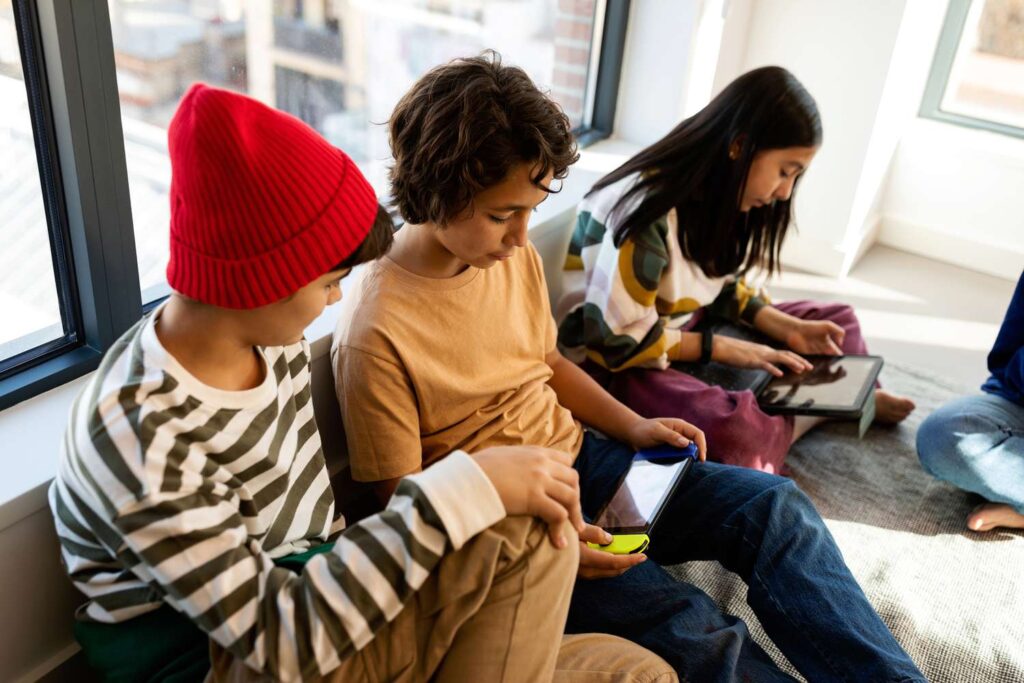Social media is now woven into the fabric of everyday teenage life, but for some adolescents, scrolling, posting, and seeking validation online crosses the line from casual use to compulsive dependency. At Paradigm Treatment, we understand the complex challenges teens face when their digital habits begin affecting their mental health, relationships, and daily functioning. Social media addiction treatment helps young people reclaim balance, build healthier coping skills, and reconnect with what truly matters.
Key Takeaways
- Too much screen time may lead to anxiety, poor sleep, and emotional dependency on digital validation
- Social media addiction treatment uses therapeutic tools, structure, and support to help teens break compulsive patterns
- A social media detox period can help reset attention, mood, and dopamine regulation
- Family (or parental) involvement and support can go a long way in helping teens build better screen time habits
Quick Read
Social media addiction affects countless teens, creating compulsive behaviors that disrupt sleep, academics, and emotional well-being. When scrolling becomes a dependency, evidence-based treatments like CBT, DBT, and family therapy can help adolescents regain control and rebuild healthier relationships with technology.
Social Media Addiction in Teens
Social media platforms are made to capture attention. Through algorithm-driven content, infinite scrolling, and dopamine-triggering notifications, these apps create feedback loops that can be difficult for developing brains to resist. Teens, whose prefrontal cortex (the area responsible for impulse control and decision-making) is still maturing, can find the pull of constant online engagement overwhelming.
The fear of missing out (FOMO), the desire for social validation, and a culture of comparison further amplify this vulnerability. What begins as innocent curiosity can evolve into compulsive checking, mood dependency on likes and comments, and difficulty being present in real-world interactions. Over time, excessive use can disrupt sleep patterns, cognition, and even family relationships.

The Effects of Excessive Screen Time for Teens
Prolonged exposure to screens does more than steal hours from a teen’s day. In one study, teens with four or more hours of daily screen time were more likely to feel less well-rested, have irregular sleep routines, and engage in less physical activity. Another study, which sought to examine the associations between screen time and mental health among adolescents, found that those who had 4-6+ hours a day of screen time were more likely to show symptoms of anxiety, depression, and stress compared to their counterparts with more than 2 hours of daily screen time.
Beyond the physiological impacts, there’s an emotional toll. Teens immersed in curated online worlds often struggle with self-esteem, as they compare their unfiltered reality to everyone else’s highlight reel. The constant need to perform, respond, and stay relevant creates a state of chronic stress that many adolescents aren’t equipped to manage alone.
When Does Social Media Use Become Harmful?
Not all social media use is problematic, but a few warning signs may suggest the behavior has crossed into addiction territory:
- Irritability or anxiety when unable to access their device
- A decline in academic performance due to distraction or late-night scrolling
- Withdrawal from in-person activities they once enjoyed
- Secrecy about online activities or screen time duration
- Emotional dependency on digital validation for self-worth
- Sleep disruption from nighttime device use
Types of Social Media Addiction Treatment
Social media addiction treatment addresses both the behavioral patterns and underlying emotional drivers of the addiction. Evidence-based therapeutic approaches, which are components of most treatment plans, include:
Cognitive Behavioral Therapy (CBT) helps teens identify and challenge the thought patterns fueling compulsive use. Through CBT, adolescents learn to recognize triggers, develop healthier coping mechanisms, and build awareness around their relationship with technology.
Dialectical Behavior Therapy (DBT) focuses on emotional regulation and mindfulness. DBT teaches distress tolerance and interpersonal effectiveness, reducing the need to seek emotional relief through screens.
Family Therapy creates space for open communication about boundaries, modeling healthy tech habits, and understanding how family dynamics may contribute to problematic use. Parents learn to support recovery without enabling or becoming overly restrictive.
Group Support connects teens with peers facing similar struggles, thus helping reduce shame and isolation while fostering accountability and shared learning.
At Paradigm, we integrate these therapeutic modalities within a comprehensive treatment framework that includes education, holistic wellness practices, and individualized care planning. Our approach recognizes that digital dependency rarely exists in isolation, and it often coexists with anxiety, depression, or trauma that requires simultaneous attention. Learn more about our residential treatment for teens.
The Role of Social Media Detox
A social media detox (a structured period away from digital platforms) can serve as a powerful reset. The goal isn’t permanent abstinence, but rather developing a mindful and intentional relationship with technology. Gradual reduction strategies are more effective than cold turkey approaches for most teens. This might include:
- Designating tech-free times (meals, homework, before bed)
- Removing social media apps from phones while keeping communication tools
- Replacing scrolling habits with alternative activities
- Using screen time tracking to build awareness
How Parents Can Support Social Media Addiction Help At Home
Parents can teach their teens to build up better screen time habits at home, in addition to making room for hard conversations about social media use if it comes to that.
- Have open, judgment-free conversations about online experiences, pressures, and emotions.
- Create tech-free zones in shared spaces like bedrooms and dining areas, and establish boundaries that apply to the whole family.
- Model balanced behavior by examining and adjusting your own screen habits. Teens notice inconsistencies between what parents say and do.
- Set collaborative goals rather than imposing rules unilaterally. When teens participate in creating boundaries, they’re more likely to honor them.

Frequently Asked Questions
What is the most effective treatment for social media addiction?
The most effective approach combines evidence-based therapy (particularly CBT and DBT), structured detox periods, family involvement, and ongoing behavioral support. Treatment works best when it addresses both the addictive patterns and underlying emotional needs.
How long does it take to recover from social media addiction?
Recovery timelines vary based on severity and individual circumstances. With consistent boundaries, therapeutic support, and family involvement, many teens show noticeable improvement within weeks to months. Long-term success requires ongoing awareness and continuous skill development.
How can parents tell if their teen needs professional help?
Warning signs include withdrawal from real-life activities, emotional instability tied to online interactions, distress when social media access is limited, and failure of previous attempts to establish healthier habits. Trust your instincts, too. If you’re concerned, you can consult a mental health professional who will be able to advise you on the next steps.
Can social media use ever be healthy?
Absolutely. When used mindfully and in moderation, social media can foster creativity, connection, and learning. The key is developing awareness around intention. In other words, using platforms purposefully rather than compulsively, and maintaining balance with offline activities and relationships.
Next Steps
While family support and self-directed changes work for some teens, others require more structured intervention. Consider professional social media addiction treatment when:
- Anxiety or depression appears directly linked to online activity
- Your teen shows withdrawal symptoms or intense defiance around device limits
- Academic performance has significantly declined
- Relationships with family and friends have deteriorated
- Previous attempts at reducing use have failed
Paradigm Treatment helps adolescents navigate digital dependency alongside co-occurring mental health challenges. Our clinicians understand the unique developmental needs of teenagers and create personalized treatment plans that honor each young person’s individual circumstances while teaching sustainable coping skills. Get in touch with us today to learn more.
Cited Sources
De, D., El Jamal, M., Aydemir, E., & Khera, A. (2025). Social media algorithms and teen addiction: Neurophysiological impact and ethical considerations. Cureus, 17(1), e77145. https://doi.org/10.7759/cureus.77145 PMC
Madigan, S., Yeates, K. O., & Fearon, P. (2025). Social media use trajectories and cognitive performance in adolescents. JAMA. Advance online publication. https://jamanetwork.com/journals/jama/fullarticle/2839941
Zablotsky B, Ng AE, Black LI, Haile G, Bose J, Jones JR, Blumberg SJ. Associations Between Screen Time Use and Health Outcomes Among US Teenagers. Preventing Chronic Disease. 2025;22:240537.
https://www.cdc.gov/pcd/issues/2025/24_0537.htm
Francisquini MCJ, Silva TMS, Santos GCD, Barbosa RO, Dias PHG, Ruiz AB, Silva JMD, Stabelini Neto A. Associations of Screen Time With Symptoms of Stress, Anxiety, and Depression in Adolescents. Revista Paulista de Pediatria. 2025;43:e2023250.
https://pmc.ncbi.nlm.nih.gov/articles/PMC11385738/





 November 26, 2025
November 26, 2025 Reading Time: 7m
Reading Time: 7m